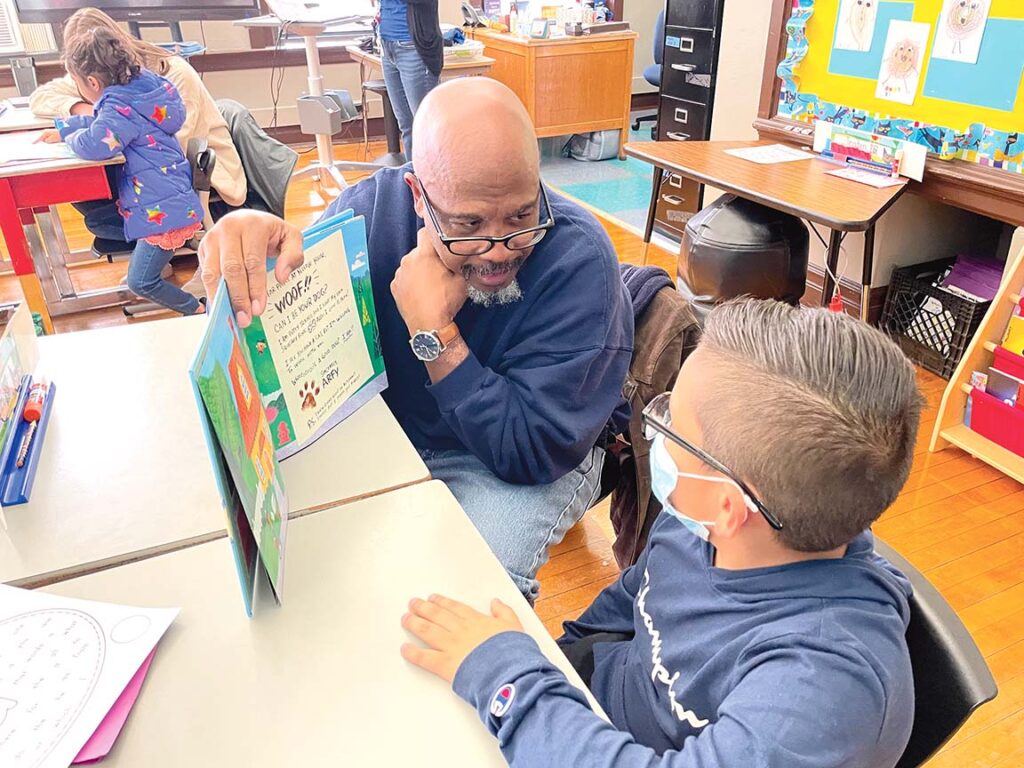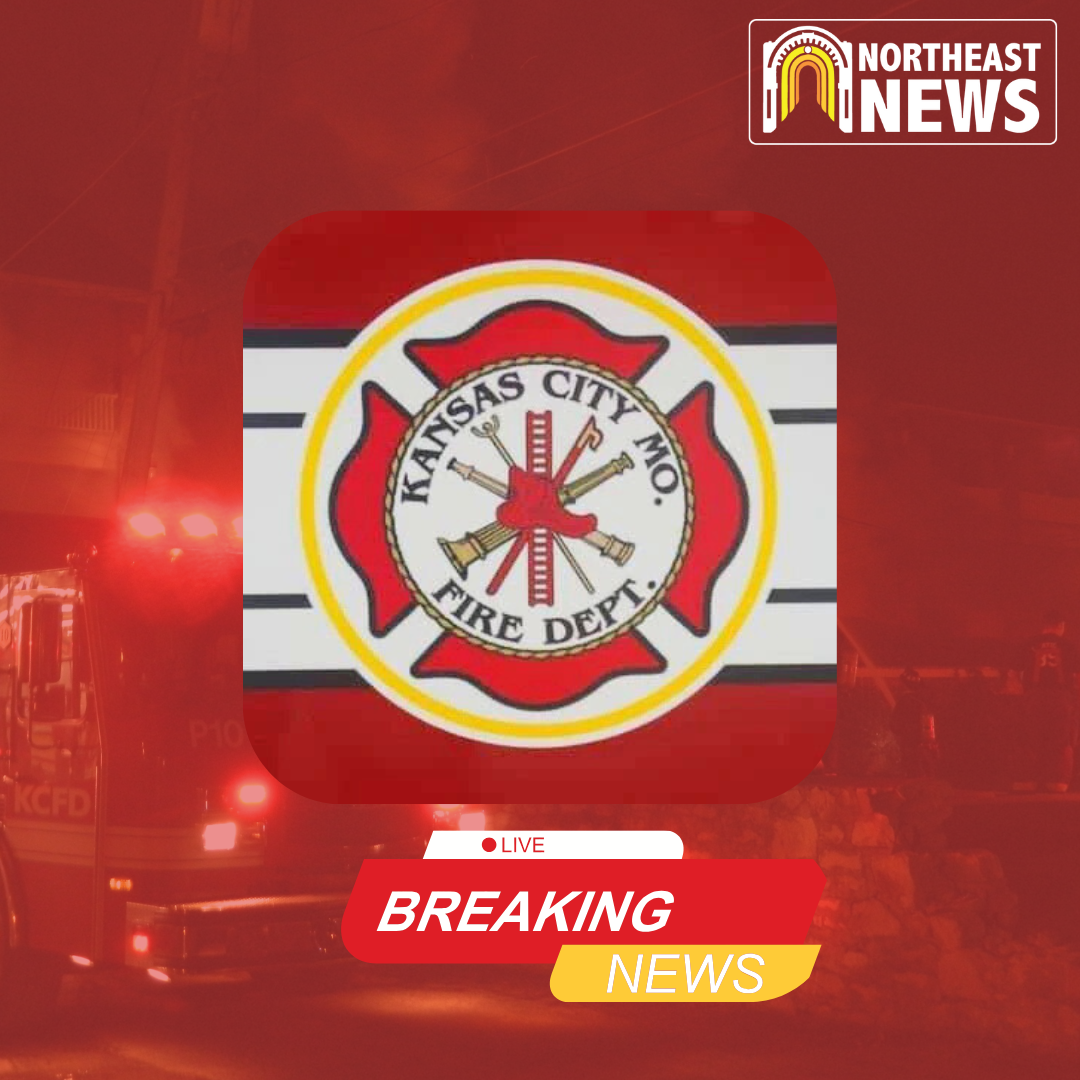
Abby Hoover
Managing Editor
In a James Elementary first grade classroom, students are paired off with adults, quietly reading or working on sight words. Their mentors are volunteers with Lead to Read KC, an organization working to increase the literacy rates in young students.
“We’re a children’s literacy organization and we’re focused on supporting the social, emotional and reading skills of, primarily, first, second and third graders, because we are helping them become proficient readers,” said Pauly Hart, president of Lead to Read KC. “By the time they leave third grade – and the reason third grade is so important is because from birth to third grade children are learning to read, they’re learning the foundations of reading, letter sounds, phonics, fluency, all of that – when they reach fourth grade, they are expected to begin reading to learn.”
Reading to learn means when that child walks into the fourth grade classroom, they are now going to be expected to learn based on the ability to read the instructions on the board, read the content on their tablet, read a math problem, and more.
“There’s examples of kids who are really good at math, and then they hit fourth grade and all of a sudden they’re struggling and it’s because they’re good with numbers, but they can’t read,” Hart said. “So reading is the foundation for all future learning. In fact, 85% of learning past third grade is based on the ability to read, so we really need to help these kids become strong readers by the end of third grade so that they can become successful students, and they are the future workforce.”
Kansas City is in a reading crisis, Hart said. In Kansas City Public Schools (KCPS) and the public charter schools, only 20% of third graders are reading at grade level.
“So that means 80% of those students are below grade level,” Hart said. “That sets them up to become some of the lowest earners down the road in the future, in our society. It sets them up to be four times more likely to drop out of high school.”
Many societal issues stem from the inability to read, including unemployment and underemployment. Poor health outcomes are also directly related to low literacy, as well as involvement in crime – both as the victim or the perpetrator – homelessness, abuse, neglect, mental health and more.
“Honestly, if we could help children become stronger readers and become successful students, they have so many options in front of them,” Hart said. “And that’s really the goal, to make sure that all of these kids have the options to do what they want to do in life to fulfill their dreams. If they’re not becoming these successful, solid students, their options have dwindled tremendously.”
The COVID-19 pandemic made the literacy situation worse in Kansas City, Hart said.
“We have a crisis on our hands, and it’s one that will affect every single person in this city, because it’s our future workforce,” Hart said. “And if we have a group of children, a generation of people, who can’t hold jobs, can’t earn a living wage, can’t become productive in our society, it’s going to affect the whole community.”
However, there is hope, and Hart said everybody can help. Lead to Read’s volunteer program supports students and hard working teachers in the classroom with weekly mentoring and reading.
Lead to Read is in classrooms across the city and has been in Northeast at Garfield Elementary since 2015, and is new at James Elementary this year.
“We bring in caring adult volunteers that we call reading mentors, and they are paired with a student in a first, second or third grade classroom,” Hart said. “And they’re paired with that student for one full school year. So we start at the middle to end of September, and then pair them up with a student, and then once a week for 30 minutes during the adult lunch hour, they go into the school and they read and mentor their student for the course of a school year.”
By the middle of May, they’re finished, making it less than a nine month commitment.
“It’s really cool because it’s the whole class,” Hart said. “We don’t pluck out the low readers. We go and if Miss Smith has 23 students, we bring in 23 adult reading mentors, so every student in the classroom gets to have a reading mentor for the school year. That’s by design because we don’t like children to be stigmatized by being the low reader. We also believe that every child can benefit from another caring adult in their life.”
Lead to Read doesn’t measure the progress of students, that’s left to the teachers in the classrooms, but they consider each meeting a success.
“We always say when a caring adult sits down with a young student and reads and talks, eyes and hearts are opened for both of them,” Hart said. “The more reading mentors we have, the more successful we believe we are.”
Before the pandemic, they had more than 1,200 reading mentors. They’re rebuilding now, but there will always be more children to serve.
“We did a two year study with UMKC, their urban education institute, and they measured student reading abilities and attitudes towards reading, and we were thrilled with the outcome,” Hart said. “Our first graders outperformed their control groups on district reading assessments, and the second graders outperformed control groups on sight word acquisition.”
They found the program to improve children’s attitudes towards reading. KCPS provides Lead to Read with an annual report on their partnerships with their students, and the reports show they are positively influencing their attendance and their classroom behavior, as well.
Lead to Read was founded in 2011 by a husband and wife team, Lynn and Jean Rundle, who were tutoring and mentoring middle school students in the urban core.
“They were working through their church, which is also located in the urban core, and what they realized with these middle schoolers is that the real problem was that they couldn’t read,” Hart said.
Both educators by training, they began researching and found that third grade is the turning point for literacy.
“We have to get these kids reading proficiently by the end of third grade, or the majority of them will not recover, will not become proficient, if they aren’t proficient by the end of third grade, if they don’t get these interventions,” Hart said. “They ended up having a friend who was a third grade teacher in KCK at Whittier Elementary – which, don’t get confused because there’s a Whittier in KCPS, too – and so they went over to her third grade classroom and brought some friends with them and paired people up one-to-one and just tried it.”
It worked. They knew they were on to something – everybody knew it – so the next fall, they recruited more volunteers and started going into more classrooms.
After a couple years of slow growth, Hart joined the team and the program has been expanding quickly ever since.
“We realized early on, through a partnership with Burns & McDonnell, that we can really grow this program through corporate partnerships, and it’s so important for the business community to engage with us because these are their future employees,” Hart said. “They have a vested interest in helping these students. So businesses love to partner with us because they can send their employees out to do some really great work in the community during the middle of the day, which is their lunch hour. So it’s not a lot of lost productivity.”
Whether it’s used as team building or just a chance to get out of the office, many Kansas Citians have volunteered their lunch breaks to read with students. Retirees, self-employed people and others who know the value of reading also sign up.
“There’s a background screening that every single one of them has to pass, thank goodness, right?” Hart said, in terms of qualifications, “And that they have 30 minutes once a week to give out to a child and make a difference in a child’s life.”
Gail, the James Elementary Site Coordinator, checks the class’s attendance and makes sure there are replacements for missing volunteers. She prepares the sight words, and makes sure there are enough books.
Students are ready and waiting with two books they can read, and one the mentor can read to them. Being read to, hearing the spoken words, helps with phonological awareness, said Allison White, director of the Reading and Mentoring Program.
The class of 15 is one of two first grade classes at James. Teacher Susan Holloway is a veteran educator, but is new to James.
Holloway said that with a high English Language Learners (ELL) population in her class, they need a lot of help with vocabulary and enjoying literature.
“We have these little sight word books that we do as partners every morning, so I’ve tried to tell them to just let them enjoy books, asking questions about comprehension, beginning-middle-end, characters, but you know, a lot of them just don’t have the English speaking at home. We always have free books out there to take but whether they have somebody to read it to them at home, this is the big thing.”
Holloway changes out the books in her classroom seasonally so there’s always fresh material, often relating it to holidays or to whatever they’re learning in other subjects. She reads them one or two books a day.
“I’m just trying to get that love of literature,” Holloway said. “We’re getting there. Some of them are. The light bulb starts to come on usually mid-first grade, so they’re starting to figure it out.”
They love their reading buddies, and one even calls her mentor “Grandma.” The mentors gifted their students a book for Christmas, specially chosen for their interests.
Riding the high of the Kansas City Chiefs’ recent Super Bowl win, Lead to Read is encouraging students to read for 15 extra minutes a day with the help of everybody’s favorite quarterback – Patrick Mahomes.
Read for 15, a program of Mahomes’ foundation, encourages children to read for 15 minutes every day outside of school.
“We know that they get reading time in school, but to become a strong reader, children need to be reading at home, and we’re also encouraging parents and guardians to read with their child for 15 minutes every day,” Hart said. “It will be the best part of their day, honestly, and so it’s really encouraging. We are seeing schools get super excited about the challenge.”
Students received “Read for 15” wristbands and a book, and signs around the school that picture Mahomes remind them to reach their goal.
“He is a powerful voice for these children, and if anybody can encourage children to read for 15 minutes, it’s Patrick Mahomes,” Hart said.
During the pandemic, Lead to Read started a tutoring program, which they see as the best way to help children recover from learning loss.
Tutoring Program Manager Bev Leonard, a former educator, was fortunate to have Lead to Read work in her school. She saw its great success in her school and how it affected her students and teachers. Now retired, she uses her connections with area principals to share Lead to Read.
“I worked on helping get a program called Hoot Reading together so that we could still read with our reading mentors,” Leonard said. “Hoot Reading came up with a website so that we could use their program and the kids could see the same book as the reading mentors, and they could read together.”
That was a great success, so coming out of the pandemic, they looked for ways to keep using Hoot Reading, this time for high dosage tutoring.
“We can provide a school one-to-one tutoring using this web based program where they see a live teacher, a certified teacher,” Leonard said. “The student sees the teacher and then the student sees themselves, and then they share a digital book together. This program is very successful.”
Nearly all of the students show reading growth over the five to 10-week program.
“There’s so many kids that are so far behind because of the pandemic, and their reading skills are way below where they should be in the Kansas City area,” Leonard said. “So we have, over the last two years, been in probably around seven to eight schools per semester.”
Read for 15 is in 15 schools this year.
“Some schools have really embraced this and have a big assembly and they keep reading records and reading logs,” Leonard said. “Garfield is in the Northeast, and Garfield is doing it this year. We gave the teachers posters to put out to remind the kids, and so they can remember to read every night. It’s a great program.”
Lead to Read’s robust book distribution program, Reading is Everywhere, drops off books in 45 unusual locations – barbershops, laundromats, hair salons, transitional housing, police stations, food pantries and restaurants, and more.
“We bring in a basket of books every month, and people can just take them,” Hart said. “They are labeled free and we encourage everybody to just take the books, and then every month we replenish them. When we come into a barber shop and the basket is empty, that’s a good sign. That means books have been taken out into the community. These are culturally diverse books, so they represent the children and the community.”
Lead to Read brings local children’s book authors into schools to meet students, focusing on providing kids with positive mental health and wellness strategies. The authors, whose books focus on these issues, give high energy, interactive presentations, leaving students with simple strategies to stay physically active and manage their emotions.
“We give each child a copy of that book to take home so that we’re planting that early seed to turn to books and reading to problem solve, to find information to help you in life,” Hart said. “We’re really proud of that program because it just came about when we looked at the community and the issues, and we had these wonderful authors. Three of them are African American, which is awesome because these kids get to meet an author that looks like them.”
Lead to Read is always looking for more volunteers.
“There’s thousands of children who can benefit from a personal reading mentor, and so we encourage everybody to think about their life and how they can make it work for them,” Hart said. “We know people are busy, but it’s honestly a light lift and most everybody who does it will tell you it’s the best part of the week.”
Volunteer Darryl James, pastor at Covenant Memorial Baptist Church on Van Brunt Boulevard, began this school year working with Lead to Read at James Elementary. However, his church also partners with James and Gladstone to support the staff and students.
“Anything you can do for kids is fantastic,” James said. “I think this is great. It didn’t seem like much, 30 minutes, but man, these kids, I mean, come on.”
The students get excited to see their mentors each week.
“It’s cool. I mean, I kind of wish that we had the same thing when I was coming up, and I think more than anything, it’s not so much the reading as it is that they can feel the concern that you have,” James said. “Because I don’t just read books, I say, ‘How was your day?’”
Lead to Read is seeking additional volunteers now and for future semesters to be able to reach more classrooms in Northeast.
“What we want to do is to create a love for reading,” Leonard said. “It creates a love for reading where the kids get excited about someone coming to read with them, or an author coming to present to them in the classroom.”
With many students being English Language Learners (ELL), Lead to Read welcomes bilingual volunteers, especially in Spanish.
“They just light up because it’s so important for kids to have another adult in their life that tells them, ‘This is important. Reading is important,’ and to care and to connect,” Leonard said. “I saw the kids show an improved interest in reading.”



















